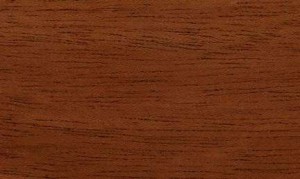Common trade names: African Mahogany.
Genus: Khaya ivorensis, Khaya spp.
Janka Hardness (pounds-force): 910
Description: Medium to coarse texture with open pores. The grain can be all over the place. Straight, interlocked, wavy, depending on the cut of the lumber and the quality of the plant. African mahogany’s heartwood is light brown to deep reddish-brown. African mahogany, like Honduras mahogany, features chatoyancy of the wood surfaces.
Location: Africa, namely: Burkina Faso, Cameroon, Central African Republic, Chad, Equatorial Guinea, Senegambia, Ivory Coast, Liberia, Mali, Nigeria, Sudan, Uganda, among others.
Common Aliases: Acajou bassam, Acajou d’Afrique, Akuk, Benin mahogany, Biribi, Bitehi, Dubini, Dukuma fufu, Dupuin, Eri Kiree, Humpe, Khaya, Khaya mahogany, Lokobua, Munyama, Ngollo, Oduben, Ogurano, Orkogho, Red mahogany, Senegal mahogany, Tiamatiama
Performance: Glues and finishes well, and is very easy to work, although the grain can tear easily once blades are slightly compromised. Sands, stains, and finishes quite well.
A wood so fine, Billy Dee Williams, Barry Gordy, and sweet Diana went and made a movie.
Common Uses: Window construction, boat building, decking, planking, ships, furniture, exterior construction, turnings, flooring, light construction, millwork, musical instruments, cabinetmaking, moldings, paneling, vehicle parts, veneers, and countless other uses.
From: The Wood Database
Common Name(s): African Mahogany
Scientific Name: Khaya spp. (Khaya anthotheca, K. grandifoliola, K. ivorensis, K. senegalensis)
Distribution: West tropical Africa
Tree Size: 100-130 ft (30-40 m) tall, 3-5 ft (1-1.5 m) trunk diameter
Average Dried Weight: 43 lbs/ft3 (685 kg/m3)
Basic Specific Gravity: .55
Hardness: 910 lbf (4,040 N)
Rupture Strength: 12,240 lbf/in2 (84,410 kPa)
Elastic Strength: 1,383,000 lbf/in2 (9,540 MPa)
Crushing Strength: 8,100 lbf/in2 (55.9 MPa)
Shrinkage: Radial: 3.7%, Tangential: 6.6%, Volumetric: 10.3%, T/R Ratio: 1.8

